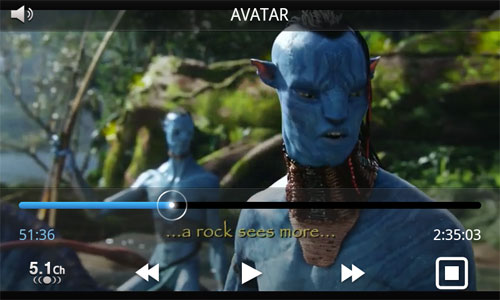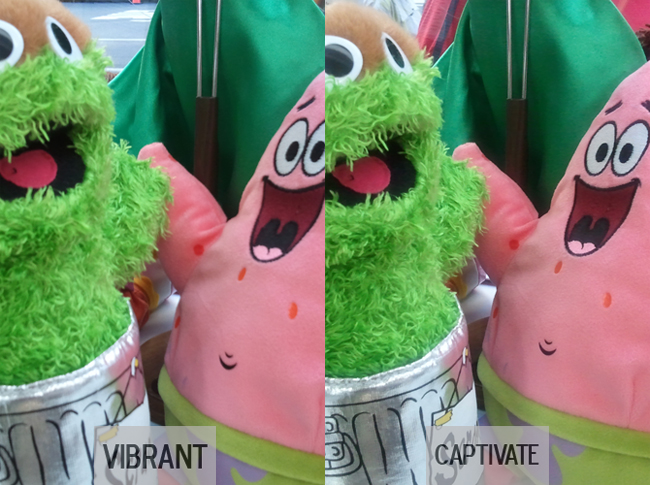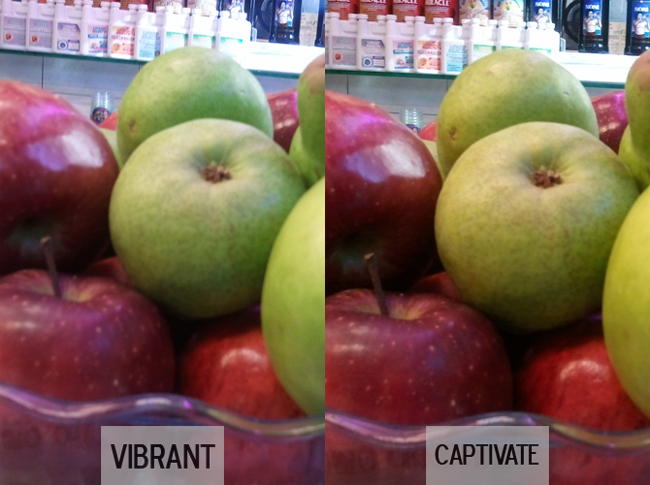Face Off: Samsung Captivate vs. Samsung Vibrant
We've recently settled some pretty tough smart phone battles, but nothing is more intense than a good ole' case of sibling rivalry. We're talking about the recently launch Samsung Captivate (AT&T) and Samsung Vibrant (T-Mobile), the first two members out the gate in the Galaxy S line. Both Android superphones sport Samsung's snappy dazzling Super AMOLED 4-inch displays, 1-GHz Hummingbird processors, and a robuts 16GB of storage. Samsung’s custom Touchwiz 3.0 interface on top of Android 2.1 (Eclair) graces each device, and they both can shoot 720p video.
So, yes, the Captivate and Vibrant are twins, but they're far from identical. And not just because one is sold by AT&T and the other by T-Mobile. Here's how these two powerhouses stack up.
Design
Both the Captivate and Vibrant house the same 4-inch Super AMOLED high-res (800 x 480) display that’s simply a sight to behold. Movies, pictures, video games-they all look glorious on either device. In almost every other way, though, these phones look quite different.
While dimensionally the same at 4.8 x 2.5 x 0.4 inches, the dark gray sides of the Captivate don’t look as sexy next to the chrome-like border of the iPhone 3G-inspired Vibrant; we prefer its more rounded corners. They both have touch-sensitive capacitive buttons (Menu, Home, Back, and Search), but the space between the bottom of the display and the bottom edge of each phone (where the buttons are housed) is wider on the Vibrant, making them more comfortable to touch. We found ourselves touching the bottom edge of the phone on the Captivate more than we liked. The same buttons are also brighter on the Vibrant, making them easier to see in all lighting conditions.
On the other hand, we prefer the metal backplate of the Captivate over the glossy, more slippery plastic one of the Vibrant. The sliding hinge on the Captivate also makes it much more user friendly to access the battery over the small slot (beneath the phone) used to pry open the Vibrant. At times we feared we might damage the case if we applied to much pressure. The volume rocker on the Captivate is more contoured than the flat one on the Vibrant, making it easier to adjust, and the power/lock key on the Captivate is also larger and easier to press.
Winner: Draw. Both phones are svelte and pocket friendly. The sturdier metal backplate, and user-friendly opening mechanism on the Captivate balances with the brighter, more spacious capacitive buttons on the rounder Vibrant.
Sign up to receive The Snapshot, a free special dispatch from Laptop Mag, in your inbox.
Specs and Performance
Under the hood, the Captivate and Vibrant have identical guts, including Samsung’s 1-GHz Hummingbird processor and 512MB of RAM, so it’s no surprise that they earned comparable scores during our four main Android benchmark tests. They were all but dead even with the exception of Memory and Filesystem in the Benchmarking round. The lower score on the Vibrant could be a side-effect of having a higher number of pre-installed applications.
| Benchmark | Captivate | Vibrant |
| Fps2D (graphics) | 54 | 54 |
| Linpack for Android (speed) | 8.165 | 7.857 |
| Nbench (CPU performance) | Row 3 - Cell 1 | Row 3 - Cell 2 |
| --Memory | 2.924 | 2.979 |
| --Integer | 4.041 | 4.047 |
| --Float | 0.778 | 0.768 |
| softweg Benchmark | Row 7 - Cell 1 | Row 7 - Cell 2 |
| --Graphics | 31.62 | 31.375 |
| --CPU | 772.756 | 772.214 |
| --Memory | 645.07 | 680.58 |
| --Filesystem | 62.89 | 33.16 |
Everyday use was basically the same with both phones. For the most part, the Captivate and Vibrant ran Android 2.1 pretty smoothly. However, we did notice some slow down on both devices when opening apps or swiping between screens. Unlocking the phone and launching the camera was fast on both devices, although the camera itself performed slower on the Vibrant (more on that later).
In terms of memory, the Captivate and Vibrant both have a generous 16GB of storage, but the Vibrant ships with an extra 2GB microSD card while the Captivate packs no extras. We believe the additional memory for the Vibrant makes up for the bundled Avatar: The Movie, a 1.8GB file preinstalled on the device.
Winner: Draw. Both phones are fast performers with identical innards, and their performance numbers place them on even ground.
Included Apps/Services
Both the Captivate and Vibrant operate on Android 2.1 (Éclair) overlaid with Samsung’s Touchwiz 3.0 interface and are nearly identical. TouchWiz is to the Captivate and Vibrant as Sense is to the HTC Evo 4G, and brings a number of additions to Éclair like 7 home screens (over stock Éclair’s 5 home screens), plus an assortment of useful apps and widgets.
The Vibrant is loaded with more applications than the Captivate, but less bloatware. T-Mobile nailed down exclusives like Avatar: The Movie and The Sims 3 by EA Games -- free premium items you’re less likely to uninstall (although they can be removed). Plus, there are applications like Audio Postcard, exclusively for T-Mobile Android phones. The premium paid TelNav GPS and GoGo (an in-flight Wi-Fi application) are the only apps we would categorize as bloatware.
There are other pre-installed apps on the Vibrant, including Kindle, Layar, Slacker, and ThinkFree Office- but these are not exclusives, and can be downloaded to the Captivate as well from the Android Market, or removed from the Vibrant altogether. We do like that the Vibrant has Amazon MP3 for the default music store, rather than the clunky, often slow AT&T Music app that plagues the Captivate. We recommend Captivate users to download the Amazon MP3 app from the Android Market.
The Captivate suffers from the same problem of too many mapping/location applications that occupy AT&T’s other Android device, The HTC Aria. In addition to the extremely useful and free Google Maps Navigation, there is AT&T Family Map, AT&T Maps, AT&T Navigator, and YP Mobile. Most of these apps have features that overlap one another. Premium paid services like AT&T Radio seems unnecessary when there are free options like Pandora and Slacker (both available in the Android Market).
However, we do like the Instant Messaging app that easily connects you to AOL IM, MSN Messenger, and Yahoo Messenger--these have to be separately installed from the Android Market on the Vibrant. Other pre-installed apps include Where and Mobile Banking, which can be installed on the Vibrant as well.
AT&T restricts sideloading on the Captivate, so apps and games (EA games in particular) not in the Android Market won't work unless you root the device. T-Mobile does not impose this restriction on the Vibrant.
Winner: Vibrant. The Captivate lacks any exciting exclusives like the entertainment applications on the Vibrant. The Captivate also has way too many mapping applications, and you can't sideload apps.
Web Browsing
Both T-Mobile and AT&T have been constantly working on the expansion of their 3G networks, so we put the Captivate and Vibrant against one another in a browser battle to determine which device performs better. While AT&T may have a larger 3G footprint over T-Mobile, the numbers tell a different story, see for yourself.
| Web Test Results (seconds) | ESPN.com | Yahoo.com | Laptopmag.com |
| Vibrant | 7 | 6 | 19 |
| Captivate | 9 | 10 | 25 |
When we performed our side-by-side tests in our office, outside in Times Square NYC, and on a moving 45 minute bus commute, the Vibrant outpaced the Captivate every single time. The Vibrant downloaded ESPN.com in an average of 7 seconds compared to the 9 seconds on the Captivate. Yahoo.com loaded in 6 seconds compared to the Captivate’s 10 seconds, and our own Laptopmag.com site loaded in 19 seconds to the Captivate’s 25 seconds.
On average, the Vibrant was 29 percent faster than the Captivate. The Vibrant is not an HSPA+ device, but it does take of the network's enhanced speeds where available.
Winner: Vibrant. The Vibrant outpaced the Captivate in each test.
Camera
Both the Captivate and Vibrant have the same 5-Megapixel sensor, but in our test, they performed different. Shot-to-shot, both phones had very similar shutter speeds. Each device captured quality images, but the photos taken with the Vibrant appear to have slightly warmer colors outdoors.
Indoors was more of the same; theVibrant's images were warmer. The flowers and fruit snapped by the Captivate, however, appear slightly sharper and have more of a natural tone.
The Captivate and Vibrant were pretty much neck and neck when we captured some 720p footage. The only difference we noticed again was that the Vibrant’s colors were slightly warmer.
Winner: Draw. The Vibrant produced warmer colors in all scenarios, but the Captivate captured sharper images with more natural colors indoors. Video quality was nearly neck and neck.
Battery Life
Both phones have a 1500mAh Li-on battery, and T-Mobile claims the Vibrant has a talk time rating up to 6.5 hours with 18 days standby time, while AT&T says the Captivate has up to 5 hours 50 minutes of talk time and 14 days standby time.
In our battery test, which uses the browser to surf 60 popular websites per minute over 3G until the battery dies, the Vibrant lasted 4 hours and 26 minutes. The Captivate only endured 3 hours and 42 minutes, 44 minutes less than the Vibrant. We are currently in the process of running the battery tests again.
Winner: Vibrant. So far the Vibrant outpaces the Captivate, but we'll be updating our results once we've run our test again.
Call Quality
The 0.5-inch earpiece on both the Captivate and Vibrant produced good volume and calls were relatively clear that we received from mobile and land lines. The microphone, located under the bottom bezel on both phones, produced clear voice quality, and background noise was kept to a minimum from a voice message we left as we walked through a busy shopping mall.
Winner: Draw. With the same diameter earpiece and microphone position, both phones produced clear calls of the same quality.
Accessories
Both the Captivate and Vibrant share the same accessories, including a Battery Charger with Stand ($49.99), Silicone Gel Case ($29.99), and Bluetooth headset ($69.99). The Vibrant, however, comes with an extra battery cover in a Lavender color.
Winner: Draw.
Pricing & Value
For $80 per month, you’ll be up and running with the Vibrant on T-Mobile’s Even More 500 Talk+Text+Web plan with 500 voice minutes, unlimited data (T-Mobile will slow down your speed after 5GB of usage), unlimited mobile to mobile, and unlimited text messages. With the Captivate, AT&T’s $39.99 Nation 450 (with rollover minutes), nets you 450 anytime minutes, and unlimited mobile to mobile. Add $20 for unlimited text, and another $25 for $2GB of data ($10 per 1GB after the data cap is reached). The total comes out to $85.
Winner: Vibrant. Not only will you spend $5 less per month, T-Mobile does not charge you should you go over its data cap, and you get more voice minutes.
Overall Winner: Vibrant
The Samsung Captivate and Vibrant are two amazing phones in their own right, not to mention the best Android offering on their respective carriers, but there can only be one winner. In our 9 rounds of testing, the Vibrant and Captivate were tied neck and neck in 5 categories, but the Vibrant outpaced the Captivate in 4 crucial areas: Web browsing speed, battery life, pricing/value, and included apps.
The battery on the Vibrant lasted 44 minutes over the Captivate (we will re-run the test). Plus, T-Mobile bundles fun exclusives like Avatar: The Movie and EA's The Sims 3. We also like that you won't incur any surcharges should you go over T-Mobile's larger 5GB data cap (your download speed will decrease, however).
Overall, we like the Captivate for AT&T customers, but the Vibrant for T-Mobile is the better overall Galaxy S phone.
| Phone | Row 0 - Cell 1 | Row 0 - Cell 2 |
| Row 1 - Cell 0 | Samsung Captivate | Samsung Vibrant |
| Design | Draw | Draw |
| Specs and Performance | Draw | Draw |
| Included Apps/Services | Row 4 - Cell 1 | Winner |
| Web Browsing | Row 5 - Cell 1 | Winner |
| Camera | Draw | Draw |
| Battery Life | Row 7 - Cell 1 | Winner |
| Call Quality | Draw | Draw |
| Accessories | Draw | Draw |
| Pricing & Value | Row 10 - Cell 1 | Winner |












